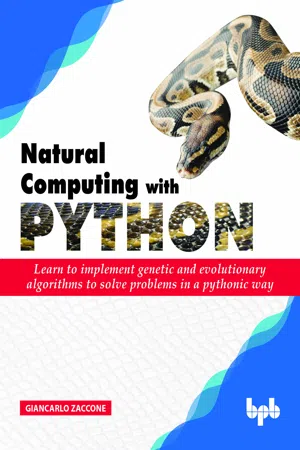
Natural Computing with Python
Learn to implement genetic and evolutionary algorithms to solve problems in a pythonic way
Giancarlo Zaccone
- English
- ePUB (disponibile sull'app)
- Disponibile su iOS e Android
Natural Computing with Python
Learn to implement genetic and evolutionary algorithms to solve problems in a pythonic way
Giancarlo Zaccone
Informazioni sul libro
Step-by-step guide to learn and solve complex computational problems with Nature Inspired algorithms. Key Features
- Artificial Neural Networks
- Deep Learning models using Keras
- Quantum Computers and Programming
- Genetic Algorithms, CNN and RNNs
- Swarm Intelligence Systems
- Reinforcement Learning using OpenAI
- Artificial Life
- DNA computing
- Fractals
Description
Natural Computing is the field of research inspired by nature, that allows the development of new algorithms to solve complex problems, leads to the synthesis of natural models, and may result in the design of new computing systems. This book exactly aims to educate you with practical examples on topics of importance associated with research field of Natural computing. The initial few chapters will quickly walk you through Neural Networks while describing deep learning architectures such as CNN, RNN and AutoEncoders using Keras. As you progress further, you'll gain understanding to develop genetic algorithm to solve traveling saleman problem, implement swarm intelligence techniques using the SwarmPackagePy and Cellular Automata techniques such as Game of Life, Langton's ant, etc. The latter half of the book will introduce you to the world of Fractals such as such as the Cantor Set and the Mandelbrot Set, develop a quantum program with the QiSkit tool that runs on a real quantum computing platform, namely the IBM Q Machine and a Python simulation of the Adleman experiment that showed for the first time the possibility of performing computations at the molecular level. What You Will Learn
- Mastering Artificial Neural Networks
- Developing Artificial Intelligence systems
- Resolving complex problems with Genetic Programming and Swarm intelligence algorithms
- Programming Quantum Computers
- Exploring the mathematical world of fractals
- Simulating complex systems by Cellular Automata
- Understanding the basics of DNA computation
Who This Book Is For
This book is for all science enthusiasts, in particular who want to understand what are the links between computer sciences and natural systems. Interested readers should have good skills in math and python programming along with some basic knowledge of physics and biology.. Although, some knowledge of the topics covered in the book will be helpful, it is not essential to have worked with the tools covered in the book. Table of Contents
- Neural Networks
- Deep Learning
- Genetic Programming
- Swarm Intelligence
- Cellular Automata
- Fractals
- Quantum Computing
- DNA Computing
-
About the Author
Giancarlo Zaccone has over ten years of experience in managing research projects in scientific and industrial areas.
He is a Software and Systems Engineer Consultant at European Space Agency (ESTEC).
Giancarlo holds a master's degree in Physics and an advanced master's degree in Scientific Computing at La Sapienza of Rome. His LinkedIn Profile: https://www.linkedin.com/in/giancarlozaccone/
Domande frequenti
Informazioni
CHEPTER 1
Neural
Networks
Introduction
Structure
- Perceptron
- Developing logic gates by perceptron
- Activation functions
- Linear and non-linear models
- Sigmoid neuron
- How neural networks learn
- Neural network architecture
- Supervised learning
- Gradient descent
- MLP Python implementation
- TensorFlow
- Logistic regression
- Conclusion
- Sitography
Biological neuron

Indice dei contenuti
- Cover
- Natural Computing with Python
- Copyright
- About the Author
- Preface
- acknowledgement
- Errata
- Table of Contents
- 1. Neural Networks
- 2. Deep Learning
- 3. Genetic Algorithms and Programming
- 4. Swarm Intelligence
- 5. Cellular Automata
- 6. Fractals
- 7. Quantum Computing
- 8. DNA Computing
- Index